|
|
|
Sort Order |
|
|
|
Items / Page
|
|
|
|
|
|
|
| Srl | Item |
| 1 |
ID:
140004


|
|
|
|
|
| Summary/Abstract |
As the end of 2015 draws nearer, the prospect of meeting all the goals of the ASEAN Economic Community (AEC) Blueprint appears dimmer by the day. The literature identifies two prominent gaps in ASEAN’s journey towards an economic community as defined by its own vision. First, the extensive literature on the AEC, and this includes the scorecard designed to monitor the implementation of its goals, suggests that there appears to be a gap between commitments and the achievements of the AEC Blueprint targets. Second, attaining a “free flow of services” as stated in the AEC goals, is also hampered by a gap between commitments in liberalization and actual practice. The objectives of this paper are twofold. First, it seeks to review the gap between commitments and practice in Malaysia. Second, it aims to examine domestic conflicts that may constrain Malaysia’s services liberalization efforts in ASEAN. A key question considered in the analysis is the source or sources of these conflicts. Is the conflict confined to the private sector or is the government conflicted from within in terms of services liberalization? In other words, are there certain policies that may negate or off-set liberalization efforts? The key finding in this paper shows conflicting objectives in government policies to be the main reason for the slow pace of liberalization thus far.
|
|
|
|
|
|
|
|
|
|
|
|
|
|
|
|
| 2 |
ID:
140003
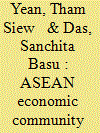

|
|
|
|
|
| Summary/Abstract |
The ten Southeast Asian economies will announce the formation of an ASEAN Economic Community (AEC) on 31 December 2015. The AEC aspires to deliver an integrated market and production base with the free movement of goods, services, capital and skilled labour. However, member economies are still a long way from achieving an integrated production space as they have not yet fulfilled all the stipulated targets set in the 2007 AEC Blueprint. A possible explanation for the current state of economic integration is the presence of conflicting domestic economic interests in member countries. This paper reviews the literature on this issue and synthesizes main observations from selected country studies examining the nature of these conflicting interests. It concludes by providing key policy recommendations for fostering domestic consensus in the respective countries studied in this special issue so that they may support the implementation of their respective commitments as well as deeper ASEAN economic integration beyond 2015.
|
|
|
|
|
|
|
|
|
|
|
|
|
|
|
|
| 3 |
ID:
180313
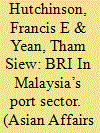

|
|
|
|
|
| Summary/Abstract |
The Belt and Road Initiative (BRI) has been characterised as a large-scale initiative to boost the movement of goods and services, capital, and people from China to Southeast Asia and beyond. Transport and logistics are a key aspect of this enterprise, with many projects focussing on railways, road networks, and ports receiving priority attention. However, BRI-related initiatives are often cast in unitary terms, with agency and autonomy almost uniquely ascribed to China-based firms and funders, and very little attributed to host country agents or their interests. Since 2013, Malaysia has received substantial inflows of BRI-related funds for infrastructure, particularly railways and ports. The Kuantan Port Expansion on Peninsular Malaysia's East Coast and the Melaka Gateway on its West Coast are two port-centred development projects associated with the BRI. Begun at the same time, these initiatives are similarly structured, as joint ventures linking large China-based state-owned enterprises with local players. Despite their similarities, these two projects have followed vastly different trajectories. While the Kuantan Port Expansion is proceeding according to schedule, the Melaka Gateway lies mired in delays and controversy. Through comparing and contrasting these two projects, this article will explore how – despite China's financial and political influence – host country actors can and do oppose, subvert, and even veto infrastructure initiatives perceived as inimical to their interests.
|
|
|
|
|
|
|
|
|
|
|
|
|
|
|
|
| 4 |
ID:
180541
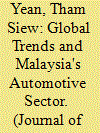

|
|
|
|
|
| Summary/Abstract |
This paper examines the development of the Malaysian automotive sector in the midst of rapid global changes in technology, consumer preferences and sustainability concerns. The sector represents a case of infant industry "protection-plus" as it includes among its objectives, the state's aspiration to nurture Bumiputra entrepreneurs as national champions for this sector. Despite close to three decades of protection, the two national cars continue to depend on foreign partners for technology support. The National Automotive Policies (NAPs) strive to push the sector towards the technology frontier with foreign and domestic investments while seeking to be a regional hub and groom national Bumiputra champions, including an impending third national car. The inherent conflicts in these objectives create disincentives for investments while the domestic market is held captive to the national car producers. Although policies continue to espouse grand visions, the reality is that Malaysia's carmakers continue to be inward looking while exports remain insignificant.
|
|
|
|
|
|
|
|
|
|
|
|
|
|
|
|
| 5 |
ID:
194361


|
|
|
|
|
| Summary/Abstract |
&KLQDDQQRXQFHGDVKLIWWRZDUGVJUHHQLQIUDVWUXFWXUH�JUHHQLQYHVWPHQWDQGJUHHQÀQDQFLQJ
at the 2019 Second Belt and Road Forum for International Cooperation in response to
criticisms of the negative environmental impact of some earlier BRI infrastructure projects.
The objective of this paper is to explore whether there has been a shift in Malaysia towards
the new green-aspired goals of the BRI in terms of green governance and projects. The key
ÀQGLQJV RI WKLV SDSHU VXJJHVW WKDW WKHUH LV QR GLVFHUQLEOH VKLIW WR JUHHQ SURMHFWV DV QRQ�
green investments are also accepted. Malaysia has requirements for green governance, but
implementation can be an issue. Host economies, like Malaysia, must take ownership of green
requirements for there to be a sustained shift towards green governance. Likewise, China’s
investments have to comply with local laws, which can improve the environmental impact
when local laws and regulations are judiciously implemented.
|
|
|
|
|
|
|
|
|
|
|
|
|
|
|
|
| 6 |
ID:
142030
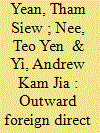

|
|
|
|
|
| Summary/Abstract |
The overall pattern of outward foreign direct investment from Malaysia indicates increasing participation in global outflows of foreign direct investment, especially to Southeast Asia. In 1980, Malaysia was ranked eleventh in the top fifteen developing and transition economies in terms of stocks of outward foreign direct investment, but it moved up to the tenth position by 2013. Outward flows surpassed inward flows after 2007 and Malaysia became a net capital exporter. This paper seeks to examine the pattern of outward foreign direct investment from the country, key motivations, and some of its impact. Government-linked companies are key players in these outward flows, especially in the oil and gas and services sector. The main findings in this paper show that outward investment from Malaysia is driven mainly by a horizontal, market-seeking type of investment while the literature indicates that its impact on trade is insignificant. Given the key role played by government-linked companies in outward foreign direct investment, an important return from these investments will be the repatriation of profits back to the home country. To promote greater transparency, these companies need to report to the public the returns and repatriation of profits on their investments abroad for Malaysia’s current and future development.
|
|
|
|
|
|
|
|
|
|
|
|
|
|
|
|
| 7 |
ID:
076451
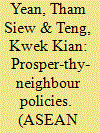

|
|
|
| 8 |
ID:
180539
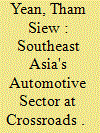

|
|
|
| 9 |
ID:
180538
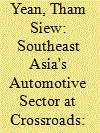

|
|
|
|
|
|
|
|